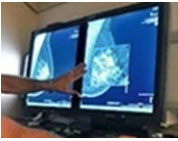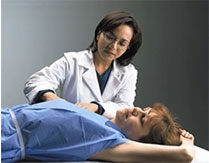Follow Up After Early Breast Cancer Treatment
Regular follow up is recommended after treatment for early breast cancer, to check whether the breast cancer has come back, to monitor for any side effects of treatment and to provide practical and emotional support. Follow up usually alternates between the breast surgeon, medical oncologist and perhaps also a radiation oncologist. Patients are given written information about the surgical breast cancer follow up schedule (PDF attached above) at either the final post-operative visit or at their 6 month post op review.
The recommended frequency and duration of follow up varies around the world and while the National Institute for Health and Care Excellence (NICE) in England, advocates follow up for only 2-3 years, in many other countries, including Australia, it is normal practice for patients to undergo specialist follow up for up to 5 years.
The purpose of follow up is to help maintain good health after treatment, which includes coping with side effects of treatment, advice on exercise and diet, reducing the risk of recurrence and detecting local recurrence. Cancer Australia in 2010 defined the aims and objectives of follow up as: to detect and treat local recurrence, to deal with adverse effects of treatment, to provide psychological support, to screen for new primary breast cancer, review and update family history, observe outcomes of therapy and review treatment including the potential for new therapies.
A diagnosis of breast cancer marks the beginning of a journey full of emotional, psychological, physical and practical challenges. While breast cancer is a major event for all who are diagnosed, it also brings with it the chance for growth. As hard as treatment can be, many breast cancer survivors have told us that the experience led them to make important changes in their lives. Having cancer and treatment often makes people think about their health in different ways. Some people decide they want to live a healthier lifestyle than they did before getting cancer. Many people look for ways to reduce the chance of their cancer coming back and preventing a new cancer developing. It’s a great time to make some changes and commit to staying healthy.
This includes: having a healthy diet, maintaining a healthy weight, stopping smoking and increasing physical activity. These simple measures may assist in preventing secondary, recurrent or a new primary breast cancer and they may also reduce many of the physical and emotional effects of cancer treatment, helping patients to survive and thrive.
The end of treatment can be both stressful and exciting. You’ll be relieved to finish treatment, yet it’s hard not to worry about cancer coming back. This is very common among people who have had cancer. Many women look forward to finishing their breast cancer treatment and getting on with life. However, for some women, the end of treatment can be a confusing or worrying time. Some people feel nervous or upset at the thought of no longer seeing members of their health care team regularly. Others feel worried about what the future holds.
In the past, routine surgical follow up visits had the main aim of detecting recurrent or new primary breast cancer, however more recently the concept of comprehensive ‘survivorship’ care has evolved, and various models have been proposed to deliver this more complex care in an effective, streamlined, organized and efficient manner.
Rapid expansion in the follow up workload has occurred through a combination of the ageing of the population, leading to increasing numbers in the cancer prone age groups, and improving outcomes of treatment, massively expanding the pool of survivors. The incidence of breast cancer in Australia is increasing: in 2010, the number of new cases of breast cancer diagnosed in women increased to 14,181, from 5,303 in 1982. In 2020, about 20,000 Australian women were diagnosed with breast cancer. Early diagnosis and improved treatment outcomes have increased breast cancer survival rates, which has in turn led to increasing numbers of women undergoing follow up after completion of primary treatment. Between 1982–1987 and 2012–2016, the five-year survival from breast cancer increased from 72% to 91% and the ten year survival is now 83%.
The escalating workload involved in providing routine long term follow up for the increasing numbers of breast cancer survivors is unsustainable for breast surgeons, whose main clinical priority has to be to provide surgical care for women with newly diagnosed breast cancer. The component of breast cancer follow up provided by the breast surgeon has traditionally focused primarily on the detection of local recurrence or new primary breast cancers in any remaining breast tissue, with a combination of clinical examination and annual breast imaging.
With modern treatment, the risk of local recurrence after breast conserving surgery is actually now extremely low, and as such, the direct involvement of the breast surgeon after the first twelve months post-surgery has become less important. Early in my career, in the 1980s, when breast conserving surgery was relatively new, local recurrence rates of 5% per annum after lumpectomy were not uncommon. That still meant that 95% of women per year did not experience a recurrence in the treated breast, but nowadays when local recurrence rates are commonly less than 0.5% /annum, and most are detected on annual imaging when very small. The reduction in local recurrence has occurred as a result of advances in surgical technique, increased pathological attention to margins, more universal use of radiation after breast conserving surgery and also the role of drug therapies, especially anti-hormonal therapy.
Since the concept of comprehensive ‘survivorship’ care has evolved, various models have been proposed to deliver this more complex care in an effective, streamlined, organized and efficient manner. Alternative models of follow up that have been studied include ‘shared care” programmes with increased involvement of general practitioners, and those utilising breast physicians (doctors, usually general practitioners, with a special interest in breast disease) and breast care nurses. An Australian study, published in 2014 in the British Journal of Cancer, looking at what follow up services Australian breast cancer survivors would prefer, found that beyond the first two years from diagnosis, in the absence of a specialist led follow up, many women prefer to have their routine breast cancer follow up by a breast physician, in the dedicated local breast cancer centre.
Follow up in the treating breast cancer centre by a breast physician, allows surveillance to continue to be overseen by the operating breast surgeon, Routine annual breast imaging continues to be undertaken at the same imaging facility, which facilitates easier comparison with previous imaging, often reducing unnecessary recalls. Some lower risk patients, particularly those from outside Melbourne, may elect to be discharged to the care of their general practitioner prior to the usual 5 year mark.
“Survive and Thrive”
Both the diagnosis of cancer and the transition to cancer survivor are potential “teachable moments” described as naturally occurring life transitions or health events that have the potential to motivate individuals to adopt risk-reducing or health-protective behaviours, and we aim to capture these teachable moments to
It is well supported by evidence that women can reduce their risk of breast cancer recurrence by being regularly active, controlling their weight and maintaining a healthy, well balanced diet, and we are motivated and committed to educating patients about the benefits of adopting healthy lifestyle practices.
Lifestyle factors have been linked to the risk of developing many common malignancies, including breast cancer, and, increasingly, to prognosis. Observational evidence has shown a relationship between so-called energy balance factors (ie diet, physical activity, and body weight) and risk of cancer recurrence. Interventional work has shown that individuals who make favourable changes in these lifestyle factors after cancer diagnosis feel better, experience less fatigue, and may decrease risk of cancer recurrence. Other lifestyle behaviours, such as smoking and alcohol consumption, also have important health consequences for cancer survivors.
The evidence suggests lifestyle factors such as moderate levels of physical activity can reduce the risk of recurrence of breast cancer by 24% and reduce the risk of death by more than one third compared with inactive women. This means for women who feel well enough, undertaking as little as 3 hours of physical activity such as brisk walking or cycling each week could help them stay healthy.
You will need the Adobe Reader to view and print these documents.![]() After Your Treatment for Breast Cancer
After Your Treatment for Breast Cancer
![]() Follow Up Care for Women with Breast Cancer
Follow Up Care for Women with Breast Cancer![]() Cancernet
Cancernet
![]() Follow-up of breast cancer survivors
Follow-up of breast cancer survivors
![]() American Cancer Society/American Society of Clinical Oncology Breast Cancer Survivorship Care Guidelines
American Cancer Society/American Society of Clinical Oncology Breast Cancer Survivorship Care Guidelines
![]() ACS
ACS
![]() Recommendations for follow-up of women with early breast cancer
Recommendations for follow-up of women with early breast cancer
![]() Follow-up after treatment for breast cancer – Practical guide to survivorship care for family physicians
Follow-up after treatment for breast cancer – Practical guide to survivorship care for family physicians
![]() Information for women on shared follow-up and survivorship care for early breast cancer
Information for women on shared follow-up and survivorship care for early breast cancer
![]()



























